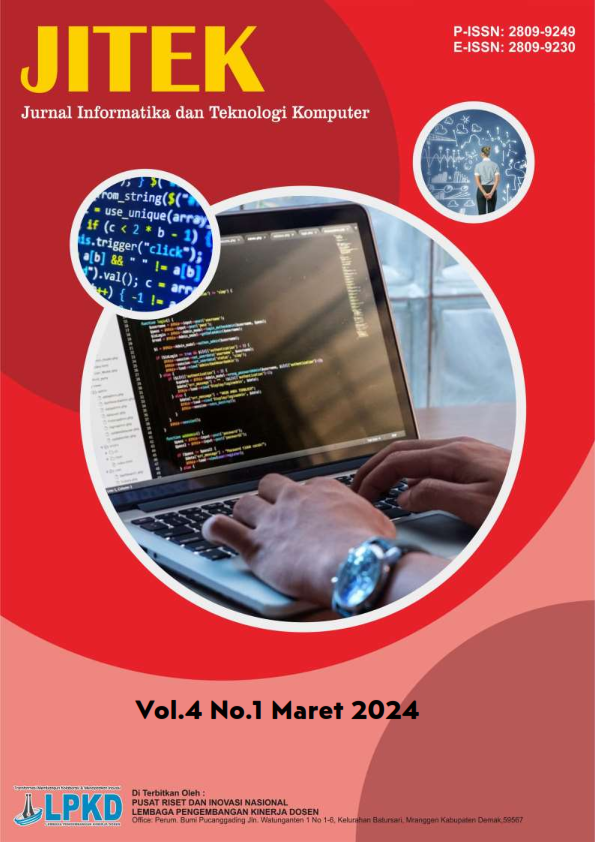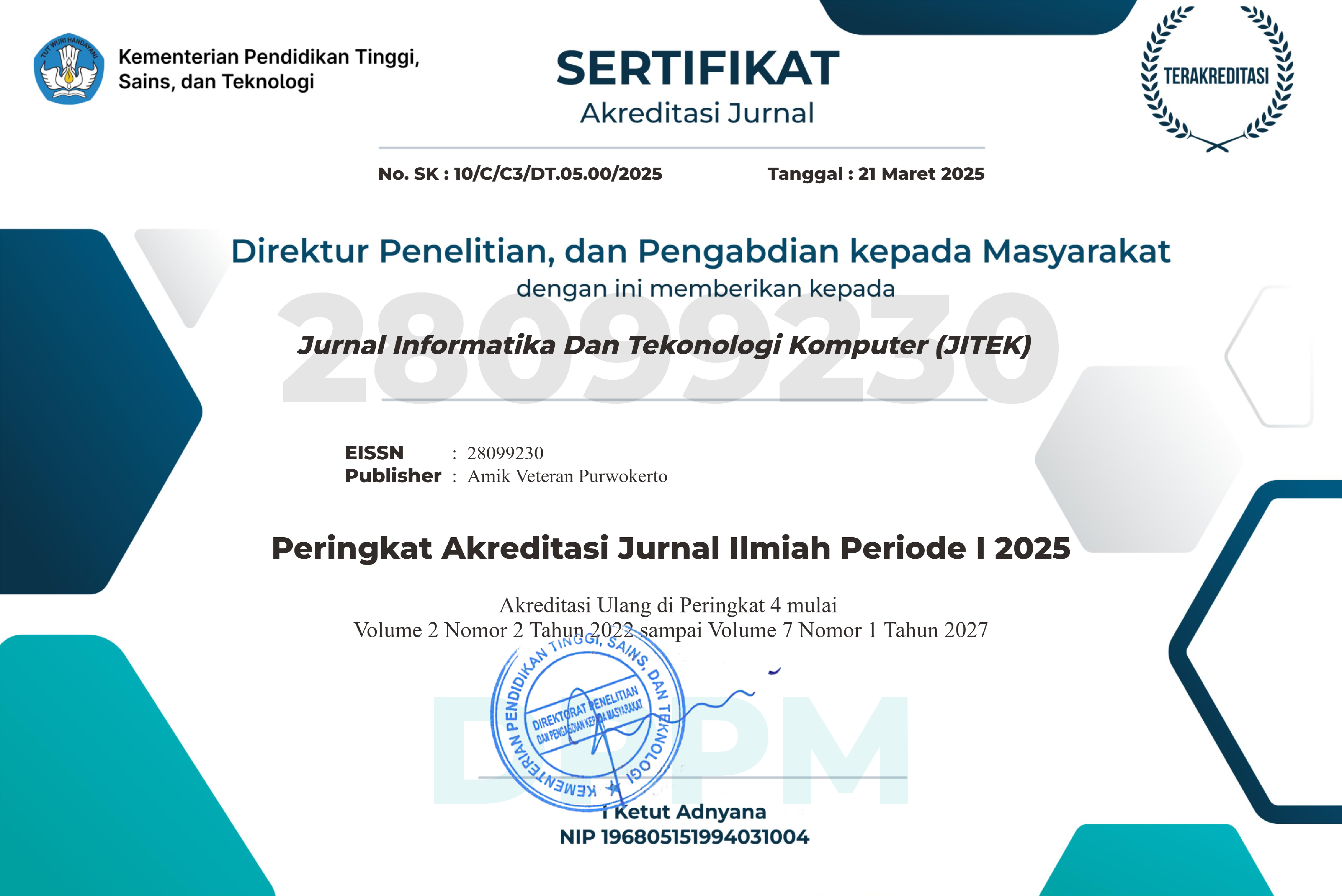Peran VPN dalam Menjaga Privasi Pengguna Jaringan Publik
DOI:
https://doi.org/10.55606/jitek.v5i1.5834Keywords:
VPN, public network`, data security`, tunneling, user privacyAbstract
The use of public networks such as free Wi-Fi is increasingly widespread along with the development of information technology. However, public networks have a high level of vulnerability to security threats such as data interception attacks in the center, and session hijacking. This study aims to examine the role of Virtual Private Network (VPN) in maintaining user privacy when accessing public networks. The method used is a literature study with a descriptive qualitative approach, based on academic literature, research reports, and the latest technical documentation. The results of the study show that VPN is able to encrypt data traffic, hide the user's IP address, and prevent unauthorized access to sensitive information. Analysis of VPN protocols such as WireGuard, OpenVPN, and L2TP/IPSec indicates that performance and level of protection vary, with WireGuard showing the highest efficiency. Although effective, the use of VPN also has limitations such as decreased connection speed and privacy risks if using untrusted services. Therefore, choosing the right VPN service and implementing good security policies are very important in efforts to protect digital privacy. This study confirms that VPN is an important component in the cybersecurity ecosystem, especially in the context of public network access.
References
[1] L. M. Silalahi, V. Amaada, S. Budiyanto, I. U. V. Simanjuntak, and A. D. Rochendi, “Implementation of auto failover on SD-WAN technology with BGP routing method on Fortigate routers at XYZ company,” Int. J. Electron. Telecommun., vol. 70, no. 1, pp. 5–11, 2024, doi: 10.24425/ijet.2024.149540.
[2] I. Bezrukov, V. Yakovlev, D. Marshalov, Y. Bondarenko, A. Salnikov, and O. P. Rodríguez, “Information technologies of the Rus-sian-Cuban GNSS service,” Int. J. Inf. Commun. Technol., vol. 24, no. 2, pp. 156–164, 2024, doi: 10.1504/IJICT.2024.137201.
[3] T. T. M. Eddy, B. B. Georges, N. E. P. Salomon, and E. M. V. Boniface, “Birth Certificates Delivery, Traceability and Authentication Using Blockchain Technology,” Int. J. Adv. Comput. Sci. Appl., vol. 15, no. 9, pp. 555–568, 2024, doi: 10.14569/IJACSA.2024.0150957.
[4] J. Mutinda, W. Mwangi, and G. Okeyo, “Sentiment Analysis of Text Reviews Using Lexicon-Enhanced Bert Embedding (LeBERT) Model with Convolutional Neural Network,” Appl. Sci., vol. 13, no. 3, 2023, doi: 10.3390/app13031445.
[5] M. J. Maenner et al., “Prevalence and Characteristics of Autism Spectrum Disorder Among Children Aged 8 Years — Autism and Developmental Disabilities Monitoring Network, 11 Sites, United States, 2020,” MMWR Surveill. Summ., vol. 72, no. 2, 2023, doi: 10.15585/mmwr.ss7202a1.
[6] A. Heidari, N. Jafari Navimipour, and M. Unal, “A Secure Intrusion Detection Platform Using Blockchain and Radial Basis Function Neural Networks for Internet of Drones,” IEEE Internet Things J., vol. 10, no. 10, pp. 8445–8454, 2023, doi: 10.1109/JIOT.2023.3237661.
[7] S. Lyeonov, W. Strielkowski, V. Koibichuk, and S. Drozd, “Impact of Internet and mobile communication on cyber resilience: A multivariate adaptive regression spline modeling approach,” Int. J. Crit. Infrastruct. Prot., vol. 47, 2024, doi: 10.1016/j.ijcip.2024.100722.
[8] S. Budiyanto and D. Gunawan, “Comparative Analysis of VPN Protocols at Layer 2 Focusing on Voice Over Internet Protocol,” IEEE Access, vol. 11, pp. 60853–60865, 2023, doi: 10.1109/ACCESS.2023.3286032.
[9] Z. Li and X. Xu, “L2-BiTCN-CNN: Spatio-temporal features fusion-based multi-classification model for various internet applica-tions identification,” Comput. Networks, vol. 243, 2024, doi: 10.1016/j.comnet.2024.110298.
[10] A. Jevremovic, Z. Kostic, I. Chorbev, D. Perakovic, A. Shalaginov, and I. Cvitic, “Energy efficiency of kernel and user space level VPN solutions in AIoT networks,” IEEE Open J. Comput. Soc., vol. 6, pp. 199–210, 2024, doi: 10.1109/OJCS.2024.3522566.
[11] Y. Gao, G. Zhang, S. Jiang, and Y. X. Liu, “Wekemo Bioincloud: A user-friendly platform for meta-omics data analyses,” iMeta, vol. 3, no. 1, 2024, doi: 10.1002/imt2.175.
[12] M. B. Palchuk et al., “A global federated real-world data and analytics platform for research,” JAMIA Open, vol. 6, no. 2, 2023, doi: 10.1093/jamiaopen/ooad035.
[13] H. L. Yin et al., “Experimental quantum secure network with digital signatures and encryption,” Natl. Sci. Rev., vol. 10, no. 4, 2023, doi: 10.1093/nsr/nwac228.
[14] Z. Liu, Q. Wei, Q. Song, and C. Duan, “Fine-Grained Encrypted Traffic Classification Using Dual Embedding and Graph Neural Networks,” Electron., vol. 14, no. 4, 2025, doi: 10.3390/electronics14040778.
[15] S. Ramraj and G. Usha, “Hybrid feature learning framework for the classification of encrypted network traffic,” Conn. Sci., vol. 35, no. 1, 2023, doi: 10.1080/09540091.2023.2197172.
[16] M. Seydali, F. Khunjush, B. Akbari, and J. Dogani, “CBS: A Deep Learning Approach for Encrypted Traffic Classification With Mixed Spatio-Temporal and Statistical Features,” IEEE Access, vol. 11, pp. 141674–141702, 2023, doi: 10.1109/ACCESS.2023.3343189.
[17] B. Sharma, L. Sharma, C. Lal, and S. Roy, “Anomaly based network intrusion detection for IoT attacks using deep learning tech-nique,” Comput. Electr. Eng., vol. 107, 2023, doi: 10.1016/j.compeleceng.2023.108626.
[18] J. Jithish, B. Alangot, N. Mahalingam, and K. S. Yeo, “Distributed Anomaly Detection in Smart Grids: A Federated Learning-Based Approach,” IEEE Access, vol. 11, pp. 7157–7179, 2023, doi: 10.1109/ACCESS.2023.3237554.
[19] J. Yu, Y. Choi, K. Koo, and D. Moon, “A novel approach for application classification with encrypted traffic using BERT and packet headers,” Comput. Networks, vol. 254, 2024, doi: 10.1016/j.comnet.2024.110747.
[20] T. Goethals, M. Al-Naday, B. Volckaert, and F. De Turck, “Warrens: Decentralized Connectionless Tunnels for Edge Container Networks,” IEEE Trans. Netw. Serv. Manag., vol. 21, no. 4, pp. 4282–4296, 2024, doi: 10.1109/TNSM.2024.3417703.
[21] I. M. Tas and S. Baktir, “Blockchain-Based Caller-ID Authentication (BBCA): A Novel Solution to Prevent Spoofing Attacks in VoIP/SIP Networks,” IEEE Access, vol. 12, pp. 60123–60137, 2024, doi: 10.1109/ACCESS.2024.3393487.
[22] A. Mozo, A. Karamchandani, L. de la Cal, S. Gómez-Canaval, A. Pastor, and L. Gifre, “A Machine-Learning-Based Cyberattack Detector for a Cloud-Based SDN Controller,” Appl. Sci., vol. 13, no. 8, 2023, doi: 10.3390/app13084914.
[23] A. Dixit, M. Bhushan, S. Yadav, M. Aggarwal, N. Kalita, and H. Singh, “Impact of Artificial Intelligence and Cyber Security as Advanced Technologies on Bitcoin Industries,” 2023 4th Int. Conf. Comput. Autom. Knowl. Manag. ICCAKM 2023, vol. 12, no. 3, pp. 131–140, 2023, doi: 10.1109/ICCAKM58659.2023.10478539.
[24] M. Lang, L. Connolly, P. Taylor, and P. J. Corner, “The Evolving Menace of Ransomware: A Comparative Analysis of Pre-pandemic and Mid-pandemic Attacks,” Digit. Threat. Res. Pract., vol. 4, no. 4, 2023, doi: 10.1145/3558006.
[25] A. Diro, L. Zhou, A. Saini, S. Kaisar, and P. C. Hiep, “Leveraging zero knowledge proofs for blockchain-based identity sharing: A survey of advancements, challenges and opportunities,” J. Inf. Secur. Appl., vol. 80, 2024, doi: 10.1016/j.jisa.2023.103678.
[26] P. Limna, T. Kraiwanit, K. Jangjarat, P. Klayklung, and P. Chocksathaporn, “The use of ChatGPT in the digital era: Perspectives on chatbot implementation,” J. Appl. Learn. Teach., vol. 6, no. 1, pp. 64–74, 2023, doi: 10.37074/jalt.2023.6.1.32.
[27] R. Al-Huthaifi, T. Li, W. Huang, J. Gu, and C. Li, “Federated learning in smart cities: Privacy and security survey,” Inf. Sci. (Ny)., vol. 632, pp. 833–857, 2023, doi: 10.1016/j.ins.2023.03.033.
[28] Z. Gao, F. Chen, Y. Wang, W. He, X. Shi, and G. Xie, “MVPN: A Defense Architecture against VPN Traffic Hijacking Based on MTD,” Electron., vol. 12, no. 3, 2023, doi: 10.3390/electronics12030711.
[29] M. M. Rashid, S. U. Khan, F. Eusufzai, M. A. Redwan, S. R. Sabuj, and M. Elsharief, “A Federated Learning-Based Approach for Improving Intrusion Detection in Industrial Internet of Things Networks,” Network, vol. 3, no. 1, pp. 158–179, 2023, doi: 10.3390/network3010008.
[30] O. Aouedi, A. Sacco, K. Piamrat, and G. Marchetto, “Handling Privacy-Sensitive Medical Data With Federated Learning: Challenges and Future Directions,” IEEE J. Biomed. Heal. Informatics, vol. 27, no. 2, pp. 790–803, 2023, doi: 10.1109/JBHI.2022.3185673.
[31] M. Fassl, A. Ponticello, A. Dabrowski, and K. Krombholz, “Investigating Security Folklore: A Case Study on the Tor over VPN Phenomenon,” Proc. ACM Human-Computer Interact., vol. 7, no. CSCW2, 2023, doi: 10.1145/3610193.
[32] G. Abbas, U. Farooq, P. Singh, S. S. Khurana, and P. Singh, “Feature Engineering and Ensemble Learning-Based Classification of VPN and Non-VPN-Based Network Traffic over Temporal Features,” SN Comput. Sci., vol. 4, no. 5, 2023, doi: 10.1007/s42979-023-01944-5.
[33] N. Bray et al., “A Latency Composition Analysis for Telerobotic Performance Insights Across Various Network Scenarios,” Futur. Internet, vol. 16, no. 12, 2024, doi: 10.3390/fi16120457.
[34] A. Dhar Dwivedi, R. Singh, K. Kaushik, R. Rao Mukkamala, and W. S. Alnumay, “Blockchain and artificial intelligence for 5G-enabled Internet of Things: Challenges, opportunities, and solutions,” Trans. Emerg. Telecommun. Technol., vol. 35, no. 4, 2024, doi: 10.1002/ett.4329.
[35] S. A. A. Mohamed and S. Kurnaz, “Classified VPN Network Traffic Flow Using Time Related to Artificial Neural Network,” Comput. Mater. Contin., vol. 80, no. 1, pp. 819–841, 2024, doi: 10.32604/cmc.2024.050474.
[36] Z. A. El Houda, A. S. Hafid, and L. Khoukhi, “MiTFed: A Privacy Preserving Collaborative Network Attack Mitigation Framework Based on Federated Learning Using SDN and Blockchain,” IEEE Trans. Netw. Sci. Eng., vol. 10, no. 4, pp. 1985–2001, 2023, doi: 10.1109/TNSE.2023.3237367.
[37] H. Zhang et al., “Classification of Brain Disorders in rs-fMRI via Local-to-Global Graph Neural Networks,” IEEE Trans. Med. Imaging, vol. 42, no. 2, pp. 444–455, 2023, doi: 10.1109/TMI.2022.3219260.
[38] M. Bahramian, R. K. Dereli, W. Zhao, M. Giberti, and E. Casey, “Data to intelligence: The role of data-driven models in wastewater treatment,” 2023. doi: 10.1016/j.eswa.2022.119453.
[39] J. T. Park, C. Y. Shin, U. J. Baek, and M. S. Kim, “Fast and Accurate Multi-Task Learning for Encrypted Network Traffic Classifi-cation,” Appl. Sci., vol. 14, no. 7, 2024, doi: 10.3390/app14073073.
[40] X. Zheng, X. Ma, Y. Jin, D. Gu, and R. Wang, “Tabular-based self-supervised learning approach for encrypted traffic classification,” J. Electron. Imaging, vol. 32, no. 04, 2023, doi: 10.1117/1.jei.32.4.043032.
[41] Z. Sui, H. Shu, F. Kang, Y. Huang, and G. Huo, “A Comprehensive Review of Tunnel Detection on Multilayer Protocols: From Traditional to Machine Learning Approaches,” Appl. Sci., vol. 13, no. 3, 2023, doi: 10.3390/app13031974.
[42] F. P. E. Putra, U. Ubaidi, A. Hamzah, W. A. Pramadi, and A. Nuraini, “Systematic Literature Review: Security Gap Detection On Websites Using Owasp Zap,” Brill. Res. Artif. Intell., vol. 4, no. 1, pp. 348–355, 2024, doi: 10.47709/brilliance.v4i1.4227.
[43] J. Cai, W. Liang, X. Li, K. Li, Z. Gui, and M. K. Khan, “GTxChain: A Secure IoT Smart Blockchain Architecture Based on Graph Neural Network,” IEEE Internet Things J., vol. 10, no. 24, pp. 21502–21514, 2023, doi: 10.1109/JIOT.2023.3296469.
[44] B. Mao, J. Liu, Y. Wu, and N. Kato, “Security and Privacy on 6G Network Edge: A Survey,” IEEE Commun. Surv. Tutorials, vol. 25, no. 2, pp. 1095–1127, 2023, doi: 10.1109/COMST.2023.3244674.
[45] A. K. Bashir et al., “Federated Learning for the Healthcare Metaverse: Concepts, Applications, Challenges, and Future Directions,” IEEE Internet Things J., vol. 10, no. 24, pp. 21873–21891, 2023, doi: 10.1109/JIOT.2023.3304790.
[46] K. Wach et al., “The dark side of generative artificial intelligence: A critical analysis of controversies and risks of ChatGPT,” Entrep. Bus. Econ. Rev., vol. 11, no. 2, pp. 7–30, 2023, doi: 10.15678/EBER.2023.110201.
[47] O. Aslanli, “Cloud and On-premises Based Security Solution for Industrial IoT,” Int. J. Inf. Eng. Electron. Bus., vol. 16, no. 5, pp. 55–62, 2024, doi: 10.5815/IJIEEB.2024.05.02.
[48] A. B. Johal and A. A. Abdulsahib, “Anatomy of Network Security Execution through Utilizing SPSS to Evaluate Public Wi-Fi,” Asia-Pacific J. Inf. Technol. Multimed., vol. 12, no. 01, pp. 111–124, 2023, doi: 10.17576/apjitm-2023-1201-06.
[49] P. F. Prasetyo, E. Putra, M. A. Mahmud, and R. Paradina, “Comparing the Performance of LoRaWAN and MQTT Protocols for IoT Sensor Networks,” vol. 6, pp. 221–228, 2024, doi: 10.60083/jidt.v6i2.565.
[50] F. Prasetyo, E. Putra, M. Riski, M. S. Yahya, and M. H. Ramadhan, “Mengenal Teknologi Jaringan Nirkabel Terbaru Teknologi 5G,” J. Sistim Inf. dan Teknol., vol. 5, no. 2, pp. 167–174, 2023, doi: 10.37034/jsisfotek.v5i1.233.
Downloads
Published
How to Cite
Issue
Section
License
Copyright (c) 2025 Jurnal Informatika Dan Tekonologi Komputer (JITEK)

This work is licensed under a Creative Commons Attribution-ShareAlike 4.0 International License.








